I first learnt how to fish plastics around the shallow rocks of Scarborough Reef and Peel Island in Moreton Bay. Flicking light tackle with 1/16oz jigheads for bream, trevally, squire and other reefies produced some of the best plastics fishing in Brisbane.
Relocating to Far North Queensland and being faced with a huge amount of shallow reefs that rarely get fished at all, especially with plastics, and with the fish being a whole lot bigger, how can I flick small plastics around Weipa and get similar results as I managed down south?
The trick was to change nothing. Well, apart from 20lb fluorocarbon leader but I am still flicking plastics on 4lb mainline and light bream tackle. Okay, you win some and you lose some but I have tried doing the same thing on heavier tackle and the odds aren’t that much better. Fishing deeper reefs in the north, where big fingermark can get nasty, means that I lose a lot more lures, however, the hook up rate is much lower as soon as the heavy tackle comes out.
Fingermark are awesome in their sporting capabilities and their eating quality but by going light on the deep reefs, I also start catching a lot more coral trout which is about the only fish that I’d prefer on the dinner plate. Even the shallow stones around the river mouths hold a lot of coral trout, be it only just legal size, and I can assure you that a 40cm coral trout is a very welcome addition to my bag.
Flicking light plastics around the shallow stones of Weipa will yield upwards of 40 fish per session so it’s great fun and a very simple way of having some serious light tackle sport fishing. Estuary cod are in plague proportions so they seem to make up the majority of the catch but coral trout, tusk fish, queenfish and even the odd barramundi manages to keep things interesting. Cod might get a little boring after a while but I still get a kick out of catching a 10kg specimen on 4lb line.
The term ‘bream tackle’ is now an acceptable term for a light 7’ rod matched with a little treadline reel spooled with fine braided line. How times have changed, 20 years ago my bream tackle was a 9’ rod with an Alvey reel spool with 12lb mono, which I still use for chasing whiting and dart in the surf but is useless when it comes to flicking light plastics around the stones.
Rods and reels are a little like soft plastics, we all have our preferred brands and as long as it fits into the ‘bream tackle’ category and the rod is a light graphite stick of around seven foot, you are in business. I still use FireLine on my threadlines due to it coming off the spool in loops that is ideal for light threadline fishing. I find the softer braids give me more tangles but as long as it is a fine, light braid, it should give you the casting distance needed for this style of fishing.
Water depth, wind and current all have an effect on the size jighead used and I will always opt for the lightest head that I can get away with. I have even started making my own jigheads again just so I can get a 0 sized split shot sinker onto a 3/0 hook. The fish up here have bigger mouths then the fish down south. The light jigheads allow me to work the lure a lot slower with a lot more pauses than I can with a 1/8oz head that I would use if the wind and current were up.
There are so many soft plastics on the market today and most are brilliant so I am not about to get into a discussion about what works and what doesn’t. If you are confident in the lure on the end of your line, you’ll catch fish with it so don’t go changing. If you are brand new and would like to know what I use, it is Berkeley Gulp.
The Berkley shrimp work on everything everywhere, the minnow was my weapon of choice down south but up in Weipa, the smaller shads on the reefs are perfect. Twitching the shads off the bottom, or down near the bottom and letting them sink again will see the fish smash the lure on the drop nine times out of ten. The lighter jigheads allows a little more room for error when avoiding the snags.
A slow sink with a couple of short but sharp twitches of the rod tip just before the lure is about to hit the bottom is the most effective technique. It can be hard to guess when the lure is about to hit the stones but a little rule of thumb is, if you are not getting snagged from time to time, you are not close enough.
Using light line requires excellent rigging and knots to get the most out of the tackle. It is amazing just how strong 4lb FireLine is when performing at its maximum. I always rig with a double in the mainline and a decky’s knot to attach the leader. The double means that no strength is lost where the mainline attaches to the leader and if using a bimini twist, very little will be lost at the knot that tied the double in the first place. Steer clear of figure eight knots and others that use some type of overhand knot that will dramatically reduce the line’s strength.
There is no doubt the fluorocarbon leaders make a huge difference to the catch rate due to their low visibility and durability. I hate having the knot of a 20lb leader ‘clunk’ through the runners of the rod, so when using leaders this heavy, I use a leader of around 60cm long and don’t let the leader knot into the guides of the rod at all. Having 60cm+ of leader hanging out of the rod tip takes a little getting used to but the knot as well as the runners will last a lot longer.
If it doesn’t have teeth, it has gill rakers like razorblades so while 20lb leader may sound heavy to the southern bream angler, it is as light as I can go and still land good fish. Fishing the shallow stones with little plastics is all about keeping it as light as possible, while still giving yourself a sporting chance.
Reads: 3958
This cod shows why 20lb leaders are necessary. The lure is down the throat with the leader running over those teeth during the fight.

DO NOT USE – same as another shot
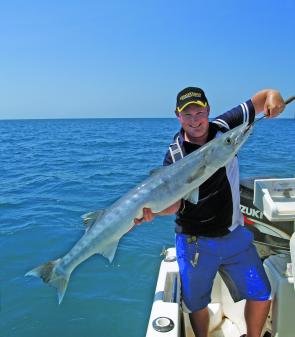
Big predators come a hunting every now and then and very occasionally it all comes together. Here a mean old pick handle (barracuda) took a liking to a soft plastic shrimp imitation fished on a light threadline outfit and incredibly lost the fight!
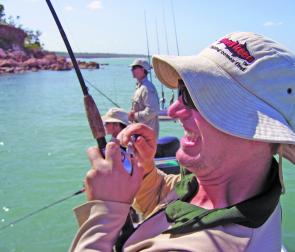
You need to get into them quick when fishing the shallow reefs around Weipa, be that with a threadline or a baitcasting outfit. Here the editorial Booth is getting drilled by a big unknown.

All sorts of fish call the shallow reefs home. From queenies to giant herring, barra to jacks and the ever present cod and parrots. You just never know when a lure will be nailed boat side.

Adam Royter with a plastic munching Weipa barra caught of the shallow reefs and rubble adjacent to the beach.
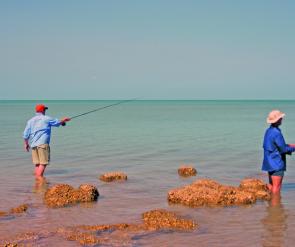
You can get out and walk the beaches if you want as there are acres of shallow reef to explore with fly, plastic or bait.
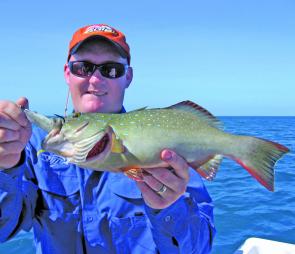
Little coral trout litter the shallow reefs of Weipa. There are much bigger versions in the shallows, they’re just hard to stop!

Golden trevally can swarm over the shallow reefs as they rest in between feeding raids on the sandy flats.

Casting lightly weighted plastics on light threadlines sounds risky but really is the best way to make the most of the shallow reefs around Weipa.
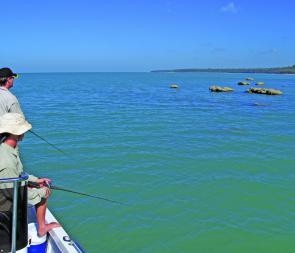
Rocky headlands are a sure sign that there will be shallow reef and rubble nearby.




